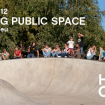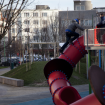About
Network 2008-2010
Human Cities is an international collaborative network supported since 2008 by the European Culture Programme 2007-2013.
The following partners were active within the first European programme:
Pro Materia, Brussels, BE
La Cambre Horta, Brussels, BE (formerly La Cambre Archictecture)
Politecnico di Milano, Milan, IT
Urban Planning Institute of the Republic of Slovenia * UIRS, Ljubljana, SLO
The Lighthouse, Glasgow, UK (defunct 2009)
Associated partners are:
Esterni, Milan, IT
prostoRoz, SLO
Research topics
Public Design
The Brussels team will focus its researches and contributions on qualitative studies based on the perception and the behaviours of people in urban public places. We propose to analyse the appropriation, the uses or the misuses of urban objects and forms by the people. We will also analyse how people divert or misuse some of these urban objects or spaces in order to find a solution to a problem they could not solve properly (ex: homeless people using public benches to sleep. Teenagers who gather in public places and around some public objects (benches,…) because they do not have a particular place to express themselves).
Sustainable Communities
The Politecnico will focus on “Social innovation and public spaces”. It starting point is how social innovation (and in particular the creative communities) may generate new and more sustainable ways of living in the city (and especially how the solutions they generates may inspire new collaborative services). From this micro scale level we now consider how these many social initiatives may scale-up and reticulate at a territory level to generate new and more sustainable cities (or Human Cities…)
Pedagogy
The Lighthouse developed a joint project between The Lighthouse Education team and its Sust. programme. It will focus its research on engaging 8 -12 year olds in the design of public space. The research will take place in an Urban Regeneration area in Scotland. A series of active learning workshop will be designed, based on knowledge gained from previous action research projects devised and delivered by The Lighthouse, culminating in an intervention in a public space.
Mapping
The Slovenian team will focus on GIS mapping methods. These methods for public space evaluation are based on the exploration of people’s engagement with public spaces. The first, “Observation & behavioural mapping”, explores physical form and dynamic patterns of spatial occupancy in parks and squares, the second, “Interviews & cognitive mapping”, examines connectedness and extension of neighbouring places in a common mental image. Thus, quality of places is addressed with the approaches which gather information and offer insights about places through the “people” component. At the same time it is of key importance that such qualities are presented in the medium designers are familiar with. Visual communication is a key communication tool in urban design profession, therefore maps and map-making are crucial components in selection of methods and techniques relevant to research in urban design and related disciplines. This is especially prominent when communicating qualitative characteristics of places which primarily concern non-spatial attributes of places such as activities people are involved with in places or conceptions of places.
Workshops
- OCT. 2008 Public Design workshop, Brussels
- FEB. 2009 Pedagogy workshop, Glasgow
- JUN. 2009 Sustainable Communities workshop, Milan
- OCT. 2009 Mapping workshop, Ljubljana
Festivals
15 – 31 March 2012
Human Cities Festival 2012: Reclaiming Public Space
29 September – 03 October 2010
Brussels Istanbul: Designing public space
06 – 16 May 2010




